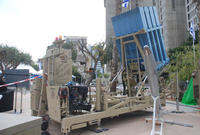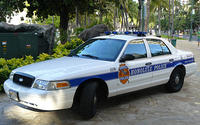-
Senators target apps that help drunk drivers avoid police

Four U.S. senators recently urged Apple, Google, and RIM to remove all apps from their online application stores that could assist drunk drivers or other criminals evade law enforcement officials; in response to the senator’s letter, RIM, announced that it would stop selling apps that help drunk drivers or criminals avoid police detection; the PhantomALERT app taps into a phone’s GPS device and alerts the driver of any active law enforcement zone including checkpoints, speed cameras, and speed traps; since the senator’s letter sales have increased nearly 3,000 percent and downloads were up by 5,000 percent; another similar app has eleven million users
-
-
Three dolphins found dead after U.S. Navy training exercise
Three dolphins died this month during a U.S. Navy training exercise using underwater explosives near the San Diego County coast; environmentalists have argued that the Navy’s sonar exercises can deafen and even kill whales and other marine life; the Supreme Court ruled in favor of the military in 2008
-
-
Israel unveils Iron Dome anti-rocket defense system

Israel on Sunday stationed the first batteries of its Iron Dome short-range missile defense system in the south of the country; the military stressed the initial deployment was experimental; after being deployed in the south, the system will then be deployed along the Lebanese border, from where Hezbollah militants fired some 4,000 rockets into northern Israel during a 2006 war; the most obvious and immediate benefit of the defensive system would be the de-fanging of the two more radical groups in the region, Hezbollah and Hamas; the system, though, is more significant in what it will allow Israel to do vis-à-vis the Palestinians: if the same rockets Hamas is firing at Israel from the Gaza Strip were to be fired from the West Bank, all of Israel’s population and economic centers will be under threat; if Iron Dome proved effective, it would make it easier for Israel to consider deep withdrawals from the West Bank, thus allowing the establishment of a viable Palestinian state without compromising Israeli security
-
-
Indian Point 50-mile evacuation plan unrealistic
Located only thirty-five miles north of New York City, the most populous area in the United States, is the Indian Point nuclear reactor; safety officials are questioning the wisdom of operating a plant so close to New York City; a fifty mile evacuation radius around the plant would affect nearly twenty million people and some say evacuating that many people on short notice is a “fantasy”; NRC is currently conducting a thorough safety review of U.S. nuclear plants and the Indian Point reactor is one of seventeen under scrutiny; New York Governor Andrew Cuomo recently called for the plant to be shut down
-
-
DigiSensory cameras predict crime before it happens
With DigiSensory Technologies’ sophisticated cameras and sensor systems, law enforcement agencies and transportation departments across the United States are now able to proactively monitor and respond to crimes or accidents as they unfold; the company’s Avista sensors process the images that its 3.2 megapixel high-resolution camera records in real time and can automatically detect when a crime is occurring; when it senses something it will alert law enforcement officials instantly; the sensors can also assist transportation departments in analyzing traffic patterns in real time; the system could allow officials to change one way streets, design real time traffic signals, and multiple speed limits to make traffic flow more smoothly
-
-
Lockheed developing autonomous and covert rover
A surveillance robot aims to operate around humans without being detected by them; the machine uses a laser scanner to builds a 3D computer model of its surroundings and uses a set of acoustic sensors to distinguish the proximity and direction of footsteps
-
-
CT scans help doctors treat sniper wounds

Determining a bullet or bomb fragment’s path through flesh and bone can help doctors treat injuries and decide which patients to prioritize; instead of relying solely on visual cues and a possibly deviated bullet path, researchers are working to develop high-resolution computed tomography (CT)-based methods of accurately determining a bullet’s trajectory
-
-
Smart traffic system to reduce first responder deaths

Nearly 13 percent of the firefighters and police officers who die in the line of duty are killed in vehicle-related incidents, and fire trucks are involved in 10 times as many collisions as other heavy truck; University of Arizona researchers have teamed up with the Maricopa County Department of Transportation (MCDOT) to create a system that will make intersections safer for emergency responders and the general public
-
-
U.S. works closely with Mexico to curb power of cartels
The United States is already involved in the spiraling violence which threatens to make Mexico into a failed state: hundreds of thousands of U.S.-made firearms are bought at U.S. gun shows and then smuggled into Mexico to arm the cartels; but there is another aspect to U.S. involvement: more and more American agents are operating in Mexico to stem the flow off drugs into the United States and curb the power of the cartels; U.S. agents generally provide intelligence and training, while Mexicans do the hands-on work; neither side will say exactly how many agents are in Mexico, citing security concerns
-
-
Border agent seizes student's laptop without warrant
On 1 May when a U.S. Customs and Border Protection agent stopped Pascal Abidor, an Islamic studies doctoral student at McGill University in Montreal, at Champlain, New York’s port of entry; the agent turned on Abidor’s computer and found a picture of a rally by the Hamas militant group, something he had downloaded from the Internet for schoolwork; Abidor’s life has not been the same since
-
-
Madison County, IL receives $260,000 in DHS grants
Two fire departments in Madison County, Illinois were recently awarded more than $260,000 in federal grants; the grants come as part of DHS’ Assistance to Firefighters program and goes toward the purchase of new safety gear and firefighting equipment; the Wood River fire department will receive $223,556 to help pay for a high-volume foam monitor as well as foam that will be used to put out chemical fires; the Rosewood Heights Fire Protection District will receive $37,050 to procure thirty sets of new protective fire suits
-
-
Ensuring cyber infrastructure in rural areas meet demand in emergencies
Research groups at the University of California, San Diego are building a scalable computer infrastructure to provide better access to camera feeds from rural areas when fires, earthquakes, flash floods, or other natural disasters hit San Diego County; approximately 1,000 people visit High Performance Wireless Research and Education Network’s (HPWREN) Web page to view camera feeds on a typical day. On a not-so-typical day — like when snow recently blanketed large swathes of rural San Diego mountaintops — the number of visitors quadrupled
-
-
Michigan law enables executives to privatize security
Michigan’s new Emergency Manager law, in addition to allowing previously negotiated union contracts to be voided, gives appointees the authority to privatize police services and jails; some are worried that the rush to cut police labor costs will impair public safety; critics say that savings from privatization are illusory
-
-
Sector Report for Tuesday, 22 March 2011: Law Enforcement Technology
This report contains the following stories.
Plus 1 additional story.
-
-
Sophisticated new police interceptors unveiled to replace Crown Vic

After serving police departments across the United States for nearly two decades, the Ford Crown Victoria police cruiser is finally set to be discontinued this year; police departments can look forward to several new models; Ford’s new car is at least 20 percent more fuel efficient than the previous model and offers higher performance; Chevy returns to the market with a powerful new interceptor that boasts a 355-horsepower 6.0-liter V8 engine; a small Indiana based firm will offer the E7 which comes with built-in license plate readers, infrared cameras, and biological threat detectors that will be able to determine the presence of biological, chemical, radiological, or nuclear threats
-
More headlines
The long view
Tantalizing Method to Study Cyberdeterrence
Tantalus is unlike most war games because it is experimental instead of experiential — the immersive game differs by overlapping scientific rigor and quantitative assessment methods with the experimental sciences, and experimental war gaming provides insightful data for real-world cyberattacks.
Using Drone Swarms to Fight Forest Fires
Forest fires are becoming increasingly catastrophic across the world, accelerated by climate change. Researchers are using multiple swarms of drones to tackle natural disasters like forest fires.
Testing Cutting-Edge Counter-Drone Technology
Drones have many positive applications, bad actors can use them for nefarious purposes. Two recent field demonstrations brought government, academia, and industry together to evaluate innovative counter-unmanned aircraft systems.
European Arms Imports Nearly Double, U.S. and French Exports Rise, and Russian Exports Fall Sharply
States in Europe almost doubled their imports of major arms (+94 per cent) between 2014–18 and 2019–23. The United States increased its arms exports by 17 per cent between 2014–18 and 2019–23, while Russia’s arms exports halved. Russia was for the first time the third largest arms exporter, falling just behind France.
How Climate Change Will Affect Conflict and U.S. Military Operations
“People talk about climate change as a threat multiplier,” said Karen Sudkamp, an associate director of the Infrastructure, Immigration, and Security Operations Program within the RAND Homeland Security Research Division. “But at what point do we need to start talking about the threat multiplier actually becoming a significant threat all its own?”
The Tech Apocalypse Panic is Driven by AI Boosters, Military Tacticians, and Movies
From popular films like a War Games or The Terminator to a U.S. State Department-commissioned report on the security risk of weaponized AI, there has been a tremendous amount of hand wringing and nervousness about how so-called artificial intelligence might end up destroying the world. There is one easy way to avoid a lot of this and prevent a self-inflicted doomsday: don’t give computers the capability to launch devastating weapons.
